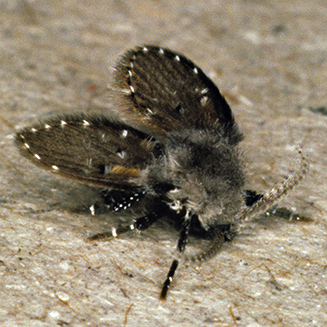|
Family: Psychodidae (mothflies, sandflies)
Life
> Eukaryotes >
Opisthokonta >
Metazoa (animals) > Bilateria > Ecdysozoa
> Panarthropoda > Tritocerebra > Phylum:
Arthopoda > Mandibulata >
Atelocerata > Panhexapoda >
Hexapoda
> Insecta (insects) > Dicondyla > Pterygota >
Metapterygota > Neoptera > Eumetabola > Holometabola > Panorpida > Antliophora
> Diptera (flies)
 |
|
Mothfly Psychoda sp., found in the bathroom. [photo Hamish Robertson] |
There are two main subfamilies in the Psychodidae: the Psychodinae
(mothflies) and the Phlebotominae (sandflies,
although there are three other subfamilies of lesser importance.
Mothflies (Psychodinae) are often found around sewerage installations. Their
larvae feed on algae, fungi and bacteria and play an important role in purifying
the sewerage. One often finds the odd moth fly around the toilet area in the
bathroom.
Sandflies (Phlebotominae) are blood suckers and
their larvae inhabit places where there is high organic matter such as in animal
burrows, termite hills and tree holes. Sandflies are best known as vectors of species in
the genus
Leishmania, causing diseases collectively known as
leishmaniasis.
Classification
- Subfamily: Bruchomyiinae
- Subfamily: Psychodinae (mothflies)
- Subfamily: Phlebotominae (sandflies)
- Subfamily: Sycoracinae
- Subfamily: Trichomyiinae
|
